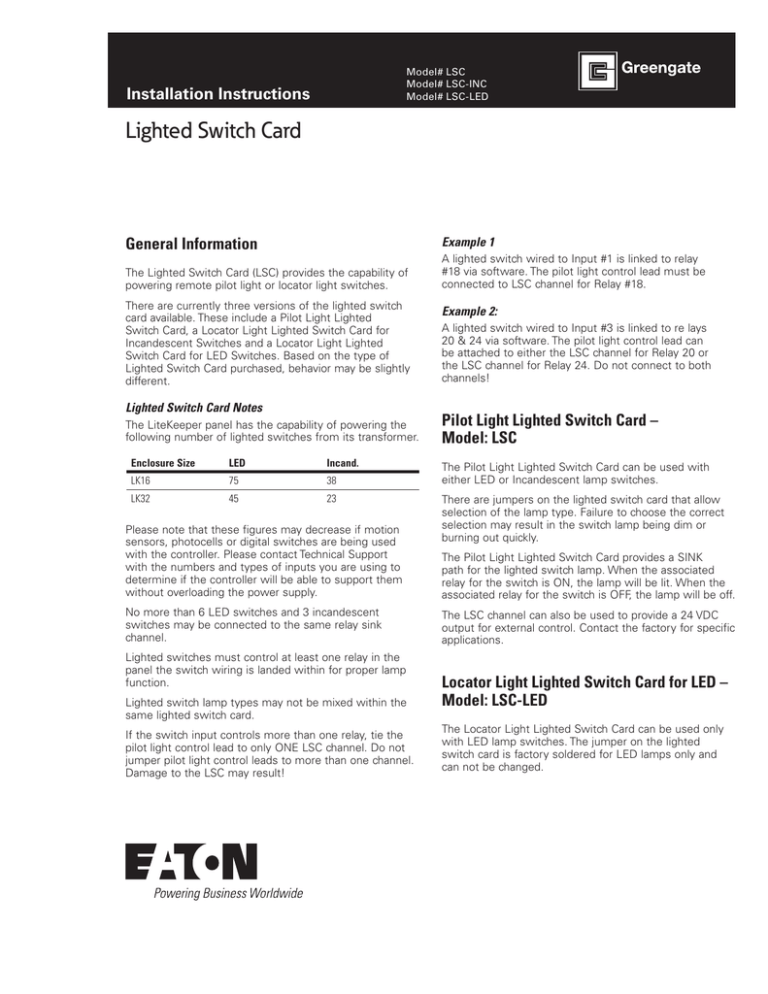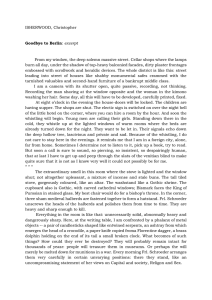
Model# LSC
Model# LSC-INC
Model# LSC-LED
Installation Instructions
INS #
Lighted Switch Card
General Information
Example 1
The Lighted Switch Card (LSC) provides the capability of
powering remote pilot light or locator light switches.
There are currently three versions of the lighted switch
card available. These include a Pilot Light Lighted
Switch Card, a Locator Light Lighted Switch Card for
Incandescent Switches and a Locator Light Lighted
Switch Card for LED Switches. Based on the type of
Lighted Switch Card purchased, behavior may be slightly
different.
Lighted Switch Card Notes
The LiteKeeper panel has the capability of powering the
following number of lighted switches from its transformer.
Enclosure Size
LED
Incand.
LK16
75
38
LK32
45
23
Please note that these figures may decrease if motion
sensors, photocells or digital switches are being used
with the controller. Please contact Technical Support
with the numbers and types of inputs you are using to
determine if the controller will be able to support them
without overloading the power supply.
No more than 6 LED switches and 3 incandescent
switches may be connected to the same relay sink
channel.
Lighted switches must control at least one relay in the
panel the switch wiring is landed within for proper lamp
function.
Lighted switch lamp types may not be mixed within the
same lighted switch card.
If the switch input controls more than one relay, tie the
pilot light control lead to only ONE LSC channel. Do not
jumper pilot light control leads to more than one channel.
Damage to the LSC may result!
A lighted switch wired to Input #1 is linked to relay
#18 via software. The pilot light control lead must be
connected to LSC channel for Relay #18.
Example 2:
A lighted switch wired to Input #3 is linked to re lays
20 & 24 via software. The pilot light control lead can
be attached to either the LSC channel for Relay 20 or
the LSC channel for Relay 24. Do not connect to both
channels!
Pilot Light Lighted Switch Card –
Model: LSC
The Pilot Light Lighted Switch Card can be used with
either LED or Incandescent lamp switches.
There are jumpers on the lighted switch card that allow
selection of the lamp type. Failure to choose the correct
selection may result in the switch lamp being dim or
burning out quickly.
The Pilot Light Lighted Switch Card provides a SINK
path for the lighted switch lamp. When the associated
relay for the switch is ON, the lamp will be lit. When the
associated relay for the switch is OFF, the lamp will be off.
The LSC channel can also be used to provide a 24 VDC
output for external control. Contact the factory for specific
applications.
Locator Light Lighted Switch Card for LED –
Model: LSC-LED
The Locator Light Lighted Switch Card can be used only
with LED lamp switches. The jumper on the lighted
switch card is factory soldered for LED lamps only and
can not be changed.
Locator Light Lighted Switch Card for Incandescent Switches – Model: LSC-INC
The Locator Light Lighted Switch Card for LED switches
provides a SINK path for the lighted switch LED. The LED
will be faintly lit at all times to allow users to locate the
switch easily. In addition, when the associated relay for the
switch is ON, the LED will burn more brightly. When the
associated relay for the switch is OFF, the LED will resume
its faintly lit state.
10. Reconnect terminal blocks for low voltage wiring and
ribbon cable connector from the Logic Board to the
Standard Override Card.
11. Proceed with the steps discussed in these instructions
WITH POWER STILL OFF TO THE LOGIC PANEL.
Locator Light Lighted Switch Card for
Incandescent Switches – Model: LSC-INC
The Locator Light Lighted Switch Card can be used only
with Incandescent lamp switches. The jumper on the lighted
switch card is factory soldered for Incandescent lamps only
and can not be changed.
The Locator Light Lighted Switch Card for Incandescent
switches provides a SINK path for the lighted switch lamp.
The lamp will be faintly lit at all times to allow users to
locate the switch easily. In addition, when the associated
relay for the switch is ON, the lamp will burn more brightly.
When the associated relay for the switch is OFF, the lamp
will resume its faintly lit state
Field Mounting to the Logic Board
In most cases, the Lighted Switch Card will be factory
mounted on the Lighting Control Panel. If it is necessary to
mount the card in the field, follow the following steps:
1. Place the Standard Override Card located in the bottom
of the enclosure in the ON position to hold lights ON if
necessary.
2. Disconnect the power connector to the Logic Panel.
3. Disconnect the ribbon cable connector from the Logic
Board to the Standard Override Card.
4. Disconnect all low voltage terminal blocks on the panel
including the network wire if applicable.
5. Using the swivel hinges on the logic board, tilt the
logic board down then take it out of the enclosure to
facilitate LSC mounting.
6. Mount the Lighted Switch Card Screw Hardware on the
Lighted Switch Card. The white plastic screw casings
should be on the backside of the LSC. The longest
screw should be mounted on the left side of the LSC in
the second hole from the bottom.
7. Position the LSC so that the 40-pin connector on the
LSC matches to the 40-pin connector on the underside
of the logic panel. Press firmly in place.
8. Secure the LSC to the logic board by inserting the long
screw through the hole in the backplate and tightening
the nut from backside of the backplate.
9. Place the control panel back into the enclosure using
the swivel hinges.
2
Selecting Switch Lamp Type (Pilot Light)
Jumpers J1, J2 and J3 determine the type of pilot light
to be driven by the LSC. Be sure to configure the jumper
correctly or damage to the LSC or pilot light switch lamp
may occur. Only one lamp type may be used per Lighted
Switch Card (incandescent or LED).
Jumpers are configurable on the pilot light model only. If
locator light lighted switch cards are being used, jumpers
will be pre-configured by the factory and cannot be
changed.
Wiring Steps
Place the jumpers in the following position for the selected
output type:
OO
J3: LED type output
OO
J2: Incandescent type output
OO
J1: Relay, 24 VDC output:
Contact the factory for further information.
3. Connect the pilot light wire to the appropriate LSC
Relay channel. (See examples earlier in the section
for information on how to determine the proper LSC
channel.
4. Once all wiring has been completed, provide power
back to the logic panel. If panel has been overridden
with the Standard Override Card Switch while being
wired, return switch to AUTO or middle position to
allow normal lighting to resume after making certain
that all necessary relays are on via the relay status
LEDs.
5. Refer to the Manual for the Lighting Controller for
programming information on linking Switch Inputs to
Relay Outputs.
WARNING: Do not wire the Lighted Switch Card inputs
or configure jumpers while power is supplied to the Logic
Board. Damage to the Logic Board will occur and warranty
will be void. Be certain Power LED is completely OFF.
Each LSC channel labeled Relays 1 through 32 provides
a current sink path. When a relay in the control panel is
activated, the corresponding LSC channel activates a sink
path allowing the lamp to light. (In locator light models,
there is a constant sink path to ground at all times as
well as the relay sink path allowing the lamp to burn
continuously and brighten when the relay is activated.)
It is important that the pilot light wire is landed on the
proper lighted switch card relay channel for proper function.
Wiring Steps
For momentary switch inputs use 18 AWG, 4 conductor
twisted wire. For maintained or two wire toggle type switch
inputs, use 18 AWG, 3 conductor twisted wire. Do not use
shielded wire for lighted switch card or switches. If shielded
wire is used, leave the shield disconnected or take special
precautions to create a single point ground for the entire
system. Make sure there are no shorts to AC Ground.
1. Make certain that power is off to the logic board.
Place override switch in ALL ON position if lighting is
necessary during wiring.
2. Connect the switch to the low-voltage input terminals
at the bottom of the lighting control panel using
instructions that came with the panel.
3
WARRANTIES AND LIMITATION OF LIABILITY
Please refer to www.coopercontrol.com under the Legal section for our terms and conditions.
Eaton
1000 Eaton Boulevard
Cleveland, OH 44122
United States
Eaton.com
Eaton is a registered trademark.
All trademarks are property
of their respective owners.
Eaton’s Cooper Controls Business
203 Cooper Circle
Peachtree City, GA 30269
CooperControl.com
Eaton est une marque de commerce
déposée. Toutes les autres marques
de commerce sont la propriété de leur
propriétaire respectif.
© 2014 Eaton
All Rights Reserved
Printed in USA
P/N: 9850-000470-00
Eaton es una marca comercial
registrada. Todas las marcas
comerciales son propiedad de sus
respectivos propietarios.




